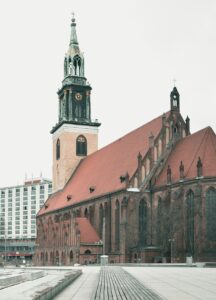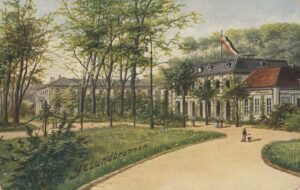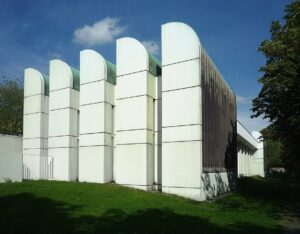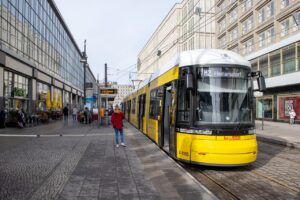Last week, we explored the history haunted Bahnhof Friedrichstrasse, and saw how vital a role the station ended up playing the history of Berlin, and by extension in the history of Europe. So today let’s jump in a bit deeper and see what there is to explore today in Europe’s most interesting train station.
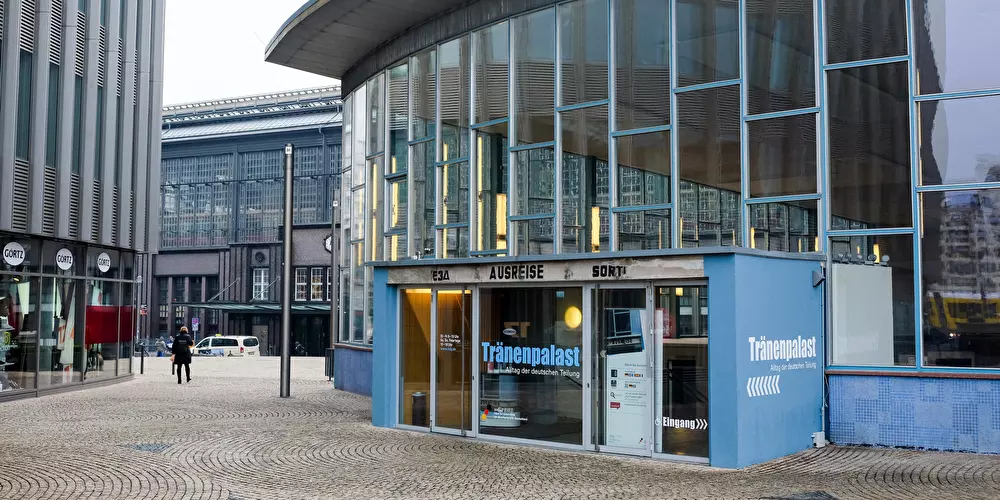
Palace of Tears – Border Crossing – Where Relatives met and departed during the Cold War
Let’s start by assuming you’re walking to the station from the north, going south, on Friedrichstrasse itself. You’ll see the train line crossing the road, an iconic view that every Berliner for a century and a half has known well. As you approach, you’ll see the station building itself loom up on the right, and just in front of it you’ll find a rather strange looking light blue building that screams early 1960s Communist architecture. You’d be right in that impression, this structure being the rather infamous so-called «Palace of Tears.» It’s open to the public every day except Monday, is free of charge, and I’d urge you to visit.
The palace was built as part of the international border crossing that occupied the majority of the train station. A few years after the Wall was built, and the original train station was too small to handle the crowds coming through, all strictly corralled and controlled, so this building was erected to ease the human crushes and inject some kind of flow into the system. The building you see today was the exit hall for West Germans only. In other words, people who had visited their relative in the East, or those few people granted exit visas to the West, departed from the Communist DDR from this building. The moniker «Palace of Tears» comes from all the tearful farewells that took place here during the madness of the Cold War division of the city.
The building still has a good many original features intact and you can walk through one of the passport lanes and luggage inspection areas. Photographs, artifacts and an excellent audio guide will fill you in on what happened here, what the process of crossing the Cold War border was like in the Palace’s heyday of the 1970s and 1980s and leaves you in little doubt as what it was like back in those seemingly cold grey days when it seemed the city would remain divided forever.
For myself, what strikes me about the architecture is the sheer amount of light that is admitted. The large windows seem to be making some sort of statement, but it’s difficult to decipher what it must be. Perhaps they wanted people to leave with a positive final impression? That was belied by the strictness of the baggage inspection and sense of general tension that permeated the area. Whatever your interpretation, it’s certainly a striking effect and worth ruminating on as you walk through this oddest of departure areas.
Another thing that may strike you, even if subliminally at first, is the fact that you have to walk down stairs to get onto the main floor where the border crossing formalities took place. The idea of descending is subtle but striking. You cannot see out, despite all those tall windows, to the street outside. It’s almost like you’ve been cut off as soon as you pass through the outer doors, like a submarine sinking from view of those you just left behind. Or perhaps the sensation of decent is a subliminal Cold War era mind game, suggesting that westerners or those allowed to go there, are somehow embarrassing and should (deserve?) to be kept from a view, a dirty little open secret, as it were. Whatever it is that you reflect upon, do take some time out to just think and absorb the oddness of what this place represented. It’s genuinely a fascinating visit and one of Berlin’s unsung sites.
Back in the day, anybody entering the Palace of Tears was on a one-way street; from here they passed through a covered way into the main station itself and corralled upstairs to a waiting S-Bahn train to take them back west, to the site of today’s Hauptbahnhof, then Lehrter Station. But today we’ll continue to walk around the station on the land side where we already are standing.

By the riverbank
Before walking too far, first have a look over the river, and you’ll see that the station partly crosses the Spree here. In the closing hours of the Battle of Berlin in 1945, groups of people, some from Hitler’s Bunker, tried to escape from the Soviets who were fast closing in from all sides. The way out of the city to the North represented the best shot at escape as the Soviets had few forces there and were distracted by the presence of the remains of the German army in the woods to the North. It was to this army and onwards to the Western Allies that those «in the know» tried to head towards. Most who attempted to make it out failed, with some being killed just across the river from where you’re standing now.
In the Cold War, this area of the river under the bridge was heavily guarded and protected to prevent people from attempting a watery escape. Doing so would have meant a long swim down a heavily watched river, but in theory a person might have made it out this way. In theory.
A wartime hanging
Head back now the way you came, get onto Friedrichstrasse itself and pass under the bridge. By the McDonald’s, look around for a small plaque on the wall. This marks the place where two young German soldiers were hanged for desertion in the closing hours of the war. These type of ad-hoc executions were fairly common as the Soviet Army approached and were designed by the SS to stiffen the German willingness to go down to the last man and last bullet.
The inscription here is very interesting. Translated literally, it reads «Shortly before the end of Hitler’s criminal war, two young German soldiers were hanged by the dehumanized SS bandits. 1952 Renewed 1999» This is a copy then of a Communist era memorial. Note the tone of the language and how it implies that the DDR represents all that is precisely the opposite of what the Hitler regime stood for. From the ashes of that regime rises a new, humane and just society, is what the subtext is here. The memorial itself is now a memorial to a lost age, a relic of a forgotten and dismissed attempt at a «brave new world.» As I say, this is indeed a station that encourages reflection as much as it facilitates transportation.
The Children Transport memorial
Finally, head around the corner to the open plaza and find the memorial group standing before you. This commemorates the so-called Kinder Transport, and called «Trains to life, Trains to death.» These two groups represent those children who managed to escape the Nazi regime, partly via this train station, to the UK and over a dozen other countries, a process began in 1938. The other group represents those children who later, after the war started, where sent, again partly from this station, to their deaths in the camps in the east. Friedrickstrasse train station saw both stories enacted during those terrible times.
As you look around the plaza, it’s shape might give away its original purpose. This was formally the main entry area, with room here for horses and carriages to turn around. The horror of children being departed to camps from here is nightmarishly underlined by the fact that a young Adolf Hitler, on leave from the army in 1916, arrived in Berlin for the first time here at Friedrichstrasse and exited by the doors in front of you. He apparently made a beeline from Friedrichstrasse station down the road to the Unter den Linden, tuned left and went right to the museums next to the city palace. As I may have mentioned, Friedrichstrasse Station invites the profoundest of reflections.

